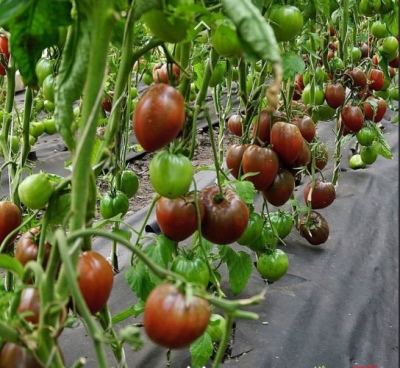
- Authors: Agrofirm "Siberian Garden"
- Category: grade
- Growth type: indeterminate
- Appointment: fresh consumption
- Ripening period: mid-season
- Ripening time, days: 100-110
- Growing conditions: for open ground, for closed ground
- Bush size: tall
- Bush height, cm: up to 180
- Bush characteristic: semi-compact
The Black Heart of America tomato, developed by the specialists of the Siberian Garden agrofirm, belongs to indeterminate varieties with a beautiful heart-shaped fruit. The unusual skin tone of such tomatoes, which is especially pronounced when grown outdoors, makes them more useful for fresh consumption. Due to the high content of anthocyanins, they have a beneficial effect on the cardiovascular system.
Description of the variety
Tomato bushes of this variety are considered tall. In open ground, the average height of the stems is up to 180 cm. The bushes themselves are semi-compact, not very growing, with medium leafiness. The first inflorescence is laid above 5-6 leaves.
The main qualities of the fruit
The skin tone of this tomato variety is brown, with dark flesh inside. The sizes of the fruits are large, the mass reaches 300-750 g. The shape of these tomatoes is round-heart-shaped, regular.
Taste characteristics
Tomatoes Black Heart of America are sweet, with pleasant fruity notes on the palate. The pulp is juicy, low-seeded, sugary at the break.
Ripening and fruiting
The tomato is mid-season, harvesting dates are in July-August. Ripening takes 100-110 days.
Yield
The variety provides up to 10-12 kg of ripe fruits from 1 sq. m. This allows us to classify it as a high-yielding one.
The timing of planting seedlings and planting in the ground
Sowing of seeds begins in March-April. The material is preliminarily prepared by disinfecting an average strength of a solution of potassium permanganate. Then they are washed, placed in a box with a nutritious soil substrate. The seedlings will be ready for picking after the appearance of 2 real leaves. The grown bushes are transferred to the ground in May-June, 55-60 days after sowing, but not earlier than the soil warms up to a temperature of +18 degrees.

Growing tomato seedlings is an extremely important process, because it largely depends on whether the gardener will be able to harvest at all. All aspects must be taken into account, from seedbed preparation to planting in the ground.
Landing scheme
For 1 sq. m have 3 plants. The standard planting pattern is 40 × 40 cm or 35 × 40 cm.

Growing and care
Tomato bushes in this variety need shaping, garter as they grow and develop. The plant is kept in 1-2 stems, depending on whether it is grown in open or closed ground. When formed with 1 central shoot, you can get fruits of record sizes. Grasshopping is carried out necessarily in order to direct the main forces of the plant to flowering and the formation of ovaries.
Fruit brushes also need to be normalized. Usually, 2-3 ovaries are left on each, but if size is not a priority, you can increase the number of future fruits.It is customary to tie a garter to a trellis or pegs, exclusively with synthetic twine.
When grown on black soil, additional feeding of tomatoes is not needed, there will be enough nutrients. On alumina or sandstone, it is necessary to establish a fertilization schedule using nitrogen compositions at the stage of growing green mass. Further, when setting fruits, potash and phosphorus combined dressings will be more beneficial. So the fruits will acquire a more pleasant taste, they will receive all the nutrition they need.




A plant needs different micronutrients at each stage of growth. All fertilizers can be divided into two groups: mineral and organic. Folk remedies are often used: iodine, yeast, bird droppings, eggshells.
It is important to observe the rate and period of feeding. This also applies to folk remedies and organic fertilizers.
Disease and pest resistance
Not all diseases are highly immune. America's black heart needs regular preventive treatments for late blight, Alternaria. Spraying is done evenly, with a range of 14 days, finishing 3 weeks before harvest. The variety is also unstable to top rot, you will have to take care of the introduction of the necessary minerals in order to prevent it. As a preventive measure, watering with calcium nitrate is suitable.


Resistant to adverse weather conditions
This variety of tomatoes is resistant to temperature fluctuations, cold-resistant. It perfectly tolerates almost any weather changes, forms ovaries without shedding, stably and evenly.
Growing regions
The tomato is zoned for cultivation in Siberia and nearby regions. The variety is also successfully cultivated in other regions of the Russian Federation, in the open field.
Review overview
Summer residents speak positively about the Black Heart of America tomato variety. Among the reviews left about him, one can single out opinions related to the taste properties of the fruits. They are praised for their sweetness, dessert flavor and pleasant aroma. Interestingly, the flesh differs in color from the skin - it has a pink-burgundy tone, very pleasant to bite through.Fruiting is extended, the first tomatoes in most regions ripen in July, and they continue to be harvested until the October cold.
Despite the assurances of breeders in the resistance of tomato bushes to adverse external influences, in cold weather with frosts in many summer residents, they are damaged in the open field, but they quickly retreat. With early sowing, you will have to take care of installing a phytolamp so that the seedlings do not stretch out. This can also be attributed to disadvantages, because the bushes after a dive quickly gain height, acquiring large sizes.

























































































